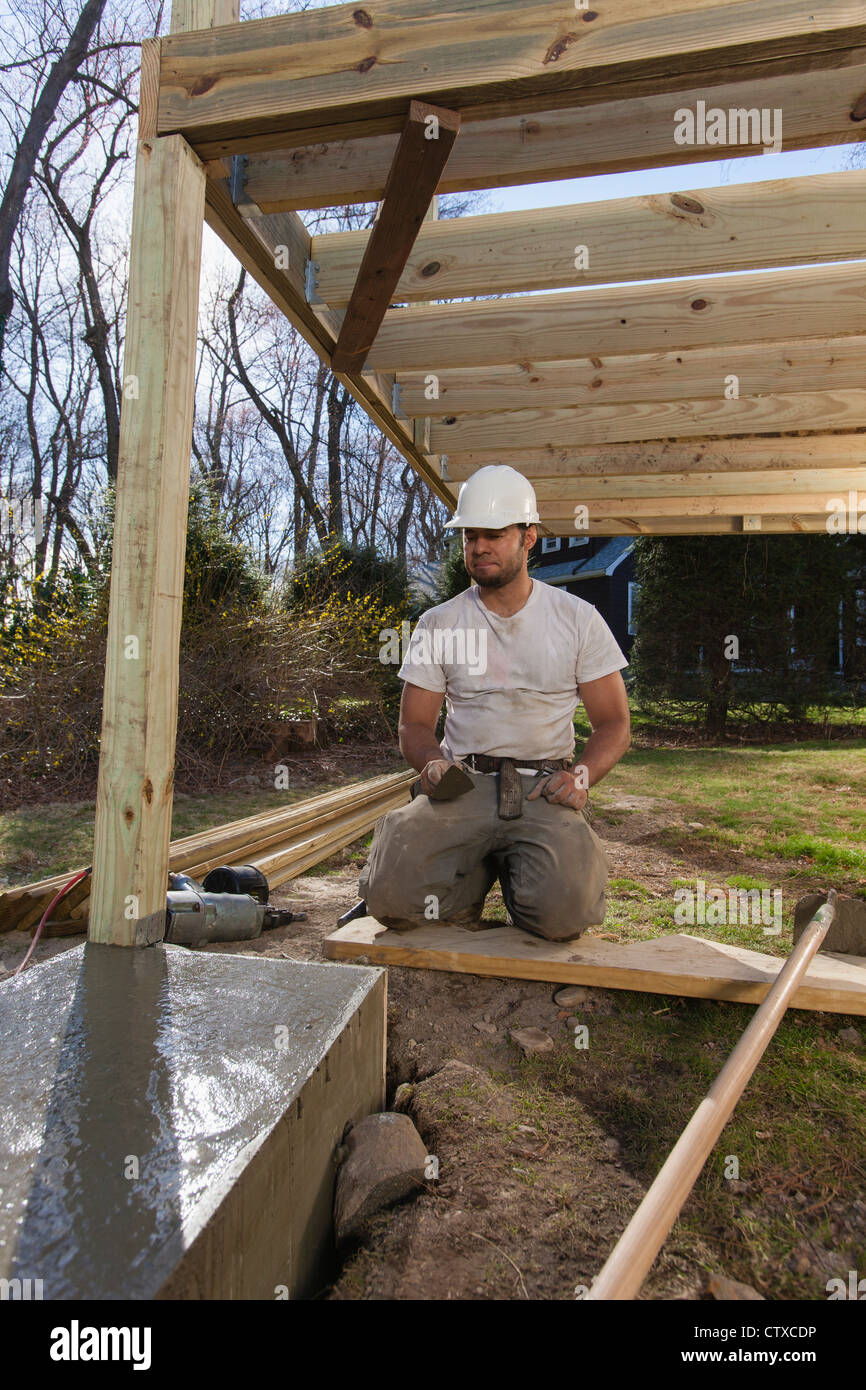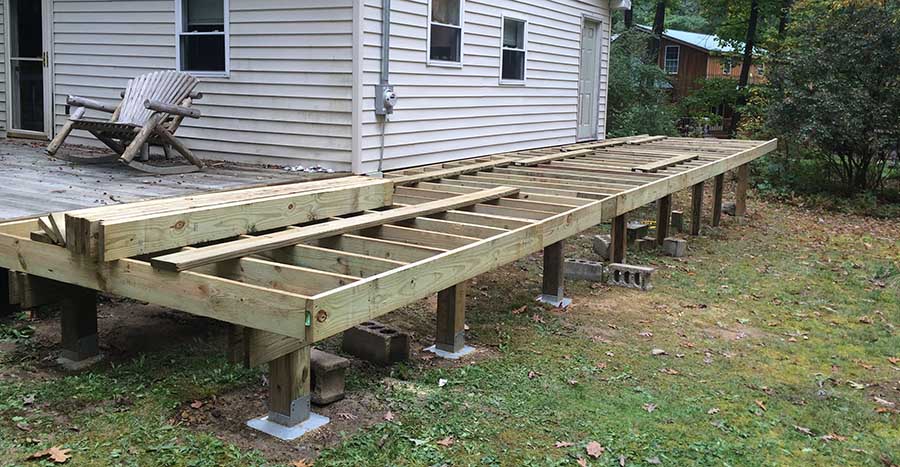Step-by-Step Deck Excellence: Making Certain Stability with Appropriately Installed Deck Footings
Maximize the Life-span of Your Deck With Solid and trusted Grounds
In order to totally optimize the life-span of your deck, it is essential to make sure that it is developed on solid and reliable footings. These footings form the foundation of your deck, offering stability and support, and are frequently the distinction in between a deck that lasts for years and one that calls for consistent fixings. In this conversation, we will explore the importance of dependable footings, the different types of strong ground materials, correct installation techniques, and just how to keep and check your deck's grounds to stop damages.
Value of Reputable Footings
The relevance of reputable grounds can not be overemphasized when it comes to taking full advantage of the life-span of your deck. The grounds function as the structure upon which the entire framework rests, offering security and assistance. Without a solid footing, the deck is at risk to moving, sinking, and even collapse, which can significantly reduce its life-span and pose security dangers.

Choosing the right type of footing is additionally vital. Working with a professional to evaluate the soil, style the grounds, and ensure proper installation is highly recommended.
Buying reputable footings might entail added price and initiative upfront, however it is a beneficial investment that will add to the long-lasting resilience and safety and security of your deck. By making sure a solid foundation, you can appreciate your deck for years to come, knowing that it is built to withstand the examination of time.
Sorts Of Strong Footing Materials
To guarantee the stability and long life of your deck, it is crucial to take into consideration the numerous types of strong ground materials readily available. The selection of footing material is essential as it provides the essential assistance and stability to stand up to the weight and tons of the deck structure.
One usual and trusted product utilized for deck footings is concrete. Concrete footings are sturdy and offer excellent security. They can be poured straight into the ground or make use of precast concrete footings for less complicated installation. Another choice is helical piers, which are steel shafts with helical plates that are screwed into the ground. These piers use outstanding load-bearing ability and can be made use of in different soil problems.
For areas with bad soil problems, such as loosened or large soils, a ground system that utilizes steel or composite piers may be preferred. Deck Footings. These piers are driven deep right into the ground to get to stable dirt layers, ensuring the stability of the deck
In many cases, deck footings can also be constructed using treated lumber. Nonetheless, it is necessary to guarantee that the lumber is effectively treated to withstand rot and degeneration triggered by exposure to wetness and pests.
When selecting a ground product for your deck, it is important to take into consideration factors such as soil conditions, climate, and regional building regulations. Consulting with a specialist service provider or structural engineer can help identify the most appropriate footing material for your certain deck task.
Correct Installment Techniques for Grounds
Considering the importance of guaranteeing stability and durability for your deck, it is necessary to understand the appropriate setup methods for grounds. The success of your deck task counts greatly on the integrity of its foundation, which is why complying with the right installation techniques is crucial.
First and foremost, it is necessary to determine the suitable size and depth of the grounds based upon the style and load requirements of your deck. This details can be gotten from building codes or through appointment with an architectural designer. As a general guideline, footings ought to go to the very least 12 inches in diameter and extend listed below the frost line to stop clearing up or moving.
When the dimensions are established, the following step is excavation. Digging the openings for the grounds ought to be finished with precision, ensuring they are deep adequate and have a level base. Deck Footings. check my source This will certainly offer a secure base for the footings
To further boost the security of the grounds, it is suggested to use a concrete mix with a toughness of at the very least 3,000 psi. This will ensure the grounds can stand up to the weight and pressures exerted by the deck.
Throughout installation, it is necessary to keep the grounds level and lined up properly. This can be accomplished by making use of a level and string lines to guide the placement of each footing.
Keeping and Inspecting Your Deck's Grounds
Normal maintenance and detailed examinations are vital for guaranteeing the lasting stability and security of your deck's grounds. Over time, footings can yield to deterioration, weather conditions, and dirt activity, which can compromise their structural stability. To make best use of the life expectancy of your deck's footings, it is critical to execute a routine upkeep regimen and conduct extensive examinations.

Furthermore, it is vital to inspect grounds for any indications of damages or damage. This includes checking for splits, splits, or falling apart concrete, along with any indications of activity or settlement. Any type of issues must be addressed immediately to stop additional damages and make certain the stability of the deck.
Moreover, it is advised to examine the bordering dirt for any type of signs of erosion or moving. Soil activity can affect the security of the footings, so it is essential to address any kind of soil-related issues quickly.
Indicators of Ground Damages and Just How to Address Them
Footing damage can position significant threats to the stability and safety of your deck, making it necessary to promptly identify and deal with any type of indicators of wear and tear. Among one of the most usual indicators of footing damages is sinking or settling of the deck. This can occur because of soil erosion, inadequate footings, or poor construction practices. If you discover that your deck is unequal or leaning, it is vital to take prompt activity Discover More to avoid further damages. Another indicator of footing damages is collapsing or splitting of the concrete footings. This can be triggered by freeze-thaw cycles, excessive moisture, or low quality concrete. If you observe any kind of fractures or degeneration in the footings, it is essential to have them inspected and fixed by an expert. In addition, if you discover any activity or shifting of the deck, such as a deck that really feels unsteady when walked on or totters when weight is applied, maybe an indication of footing damage. In such situations, it is recommended to seek advice from with an expert service provider or a structural designer to evaluate the level of the damage and determine the proper strategy. Remember, dealing with ground damage promptly can assist make certain the long-lasting security and safety of your deck.
Final Thought
In conclusion, ensuring the dependability and stamina of footings is important for making best use of the life-span of your deck. By making use of solid footing materials and correctly installing them, you can prevent damages and preserve the stability of your deck.
These footings create the structure of your deck, supplying security and assistance, and are commonly the distinction between a deck that lasts for years and one that calls for continuous repair work. In this conversation, we will certainly discover the relevance of trusted footings, the different kinds of strong footing products, proper installation methods, and how to maintain and evaluate your deck's footings to prevent damages.Regular upkeep and complete evaluations are crucial for making certain the long-lasting security and security of your deck's grounds. Bear in mind, dealing with ground damage without delay can aid make certain the long-lasting security and security of your deck.
By making use of strong ground materials and effectively installing them, you can prevent damages and maintain the security of your deck.